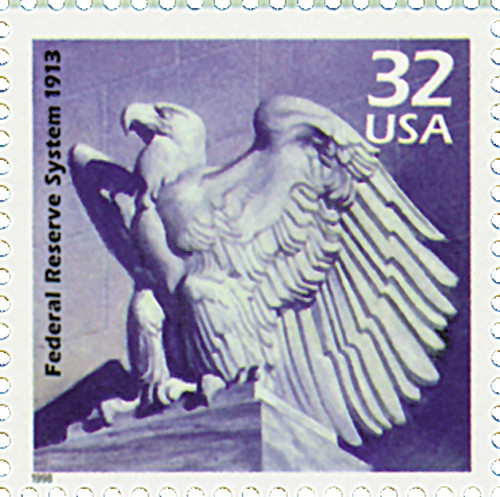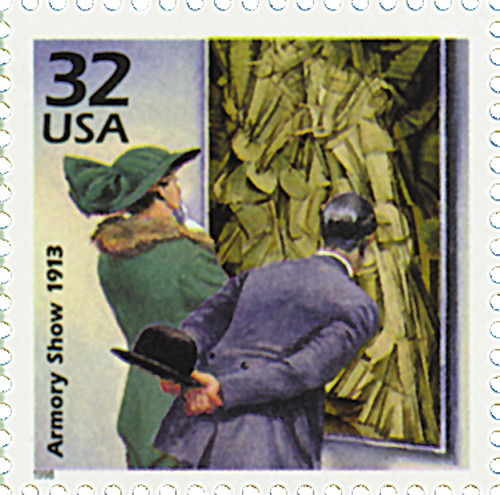
# 3183b - 1998 32c Celebrate the Century - 1910s: Federal Reserve
US #3183b
1998 Federal Reserve System 1913 – Celebrate the Century (1910s)
• Part of the second sheet in the Celebrate the Century stamp series issued from 1998-2000
• Honors the Federal Reserve System
• Includes text on the back with historical details
Stamp Category: Commemorative
Series: Celebrate the Century
Value: 32¢ First Class Mail Rate
First Day of Issue: February 3, 1998
First Day City: Washington, DC
Quantity Issued: 188,000,000
Printed by: Ashton Potter (USA) Ltd.
Printing Method: Offset, Intaglio
Format: Panes of 15
Perforations: 11.6
Tagging: Block Tagging
Why the stamp was issued: To commemorate the establishment of the Federal Reserve System and its importance in US history.
About the stamp design: Pictures an oil painting of the massive marble statue of an eagle on top of the Marriner S Eccles Federal Reserve Building in Washington, DC, by artist Dennis Lyall. Includes the following text on the back “The Federal Reserve System was created on December 23, 1913, to regulate banks and attempt to stabilize the nation’s monetary and financial system.”
First Day City: The First Day of Issue Ceremony was held in Washington, DC, with legendary radio and television host Larry King as master of ceremonies.
About the Celebrate the Century series: The USPS launched the Celebrate the Century series in 1998 to mark the end of the 20th century and herald the arrival of the 21st. The series includes 10 sheets of 15 stamps (150 in total), with each honoring important moments from a different decade (1900s, 10s, 20s, 30s, 40s, 50s, 60s, 70s, 80s, and 90s). At the time of completion, it was the longest and most ambitious commemorative stamp series in US history.
History the stamp represents: Established by the Federal Reserve Act of 1913, the Federal Reserve System is the central banking authority of the United States. Commonly known as the “Fed,” this independent governmental agency manages the country’s supply of money and credit. The Fed also provides various financial services for the federal government and the banking system, and issues our paper money.
Congress created the Fed to provide a flexible currency for the nation and to supervise the banking system. It controls the flow of money and credit int here ways: through open-market operations, the sale or purchase of government securities; by changing reserve requirements, the percentages of deposits that most banks must set aside before funds are made available for loans; and by changing the discount rate, the interest rate banks pay the Federal Reserve Bank when they borrow money.
The Fed operates with a great deal of autonomy. It does not rely on Congress for funding – operating expenses are collected from investment income and fees for its services. Although the Fed reports to Congress, it is legally free to make its own policy decisions. The Fed has promoted nationwide economic stability by working to keep interest rates low during recessions and letting them rise during periods of economic growth.
US #3183b
1998 Federal Reserve System 1913 – Celebrate the Century (1910s)
• Part of the second sheet in the Celebrate the Century stamp series issued from 1998-2000
• Honors the Federal Reserve System
• Includes text on the back with historical details
Stamp Category: Commemorative
Series: Celebrate the Century
Value: 32¢ First Class Mail Rate
First Day of Issue: February 3, 1998
First Day City: Washington, DC
Quantity Issued: 188,000,000
Printed by: Ashton Potter (USA) Ltd.
Printing Method: Offset, Intaglio
Format: Panes of 15
Perforations: 11.6
Tagging: Block Tagging
Why the stamp was issued: To commemorate the establishment of the Federal Reserve System and its importance in US history.
About the stamp design: Pictures an oil painting of the massive marble statue of an eagle on top of the Marriner S Eccles Federal Reserve Building in Washington, DC, by artist Dennis Lyall. Includes the following text on the back “The Federal Reserve System was created on December 23, 1913, to regulate banks and attempt to stabilize the nation’s monetary and financial system.”
First Day City: The First Day of Issue Ceremony was held in Washington, DC, with legendary radio and television host Larry King as master of ceremonies.
About the Celebrate the Century series: The USPS launched the Celebrate the Century series in 1998 to mark the end of the 20th century and herald the arrival of the 21st. The series includes 10 sheets of 15 stamps (150 in total), with each honoring important moments from a different decade (1900s, 10s, 20s, 30s, 40s, 50s, 60s, 70s, 80s, and 90s). At the time of completion, it was the longest and most ambitious commemorative stamp series in US history.
History the stamp represents: Established by the Federal Reserve Act of 1913, the Federal Reserve System is the central banking authority of the United States. Commonly known as the “Fed,” this independent governmental agency manages the country’s supply of money and credit. The Fed also provides various financial services for the federal government and the banking system, and issues our paper money.
Congress created the Fed to provide a flexible currency for the nation and to supervise the banking system. It controls the flow of money and credit int here ways: through open-market operations, the sale or purchase of government securities; by changing reserve requirements, the percentages of deposits that most banks must set aside before funds are made available for loans; and by changing the discount rate, the interest rate banks pay the Federal Reserve Bank when they borrow money.
The Fed operates with a great deal of autonomy. It does not rely on Congress for funding – operating expenses are collected from investment income and fees for its services. Although the Fed reports to Congress, it is legally free to make its own policy decisions. The Fed has promoted nationwide economic stability by working to keep interest rates low during recessions and letting them rise during periods of economic growth.














